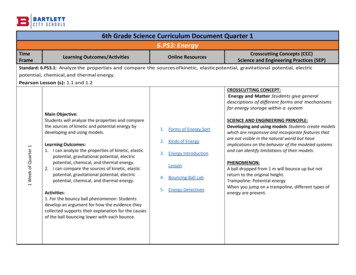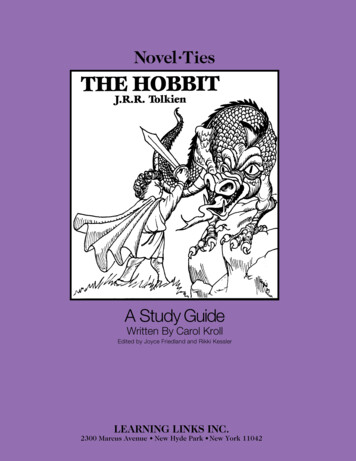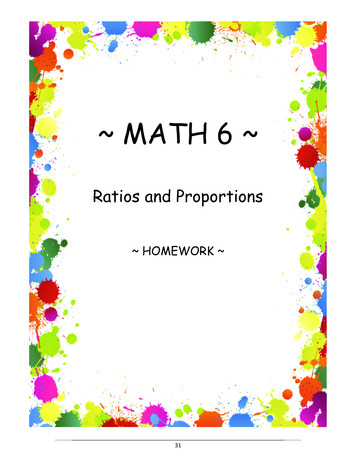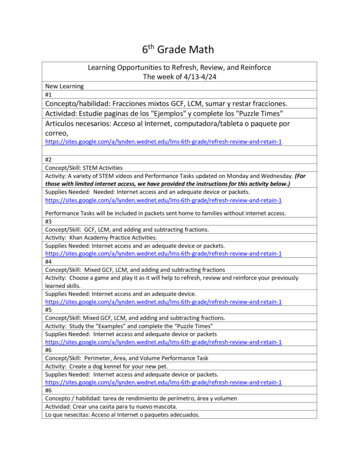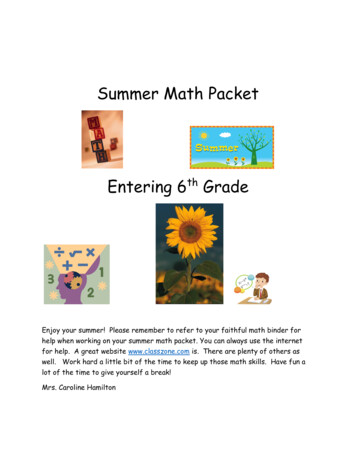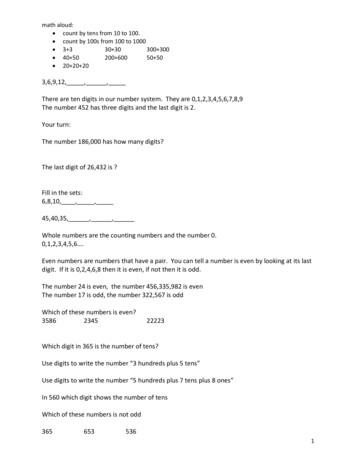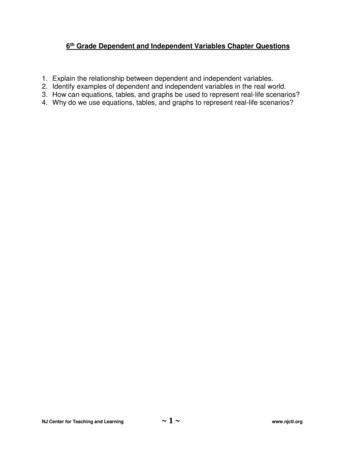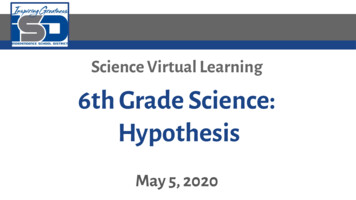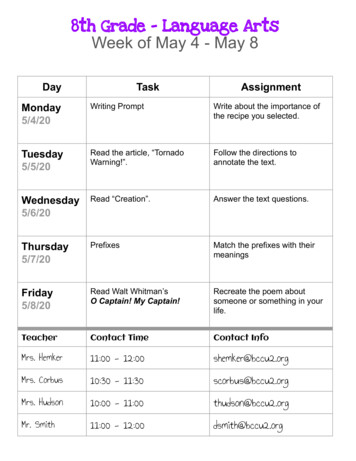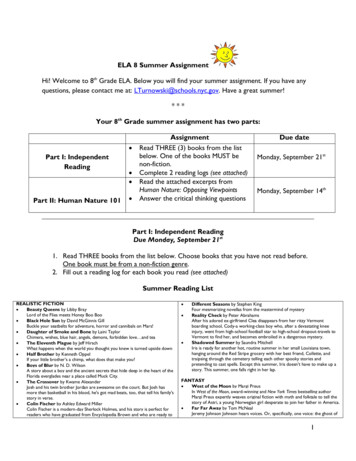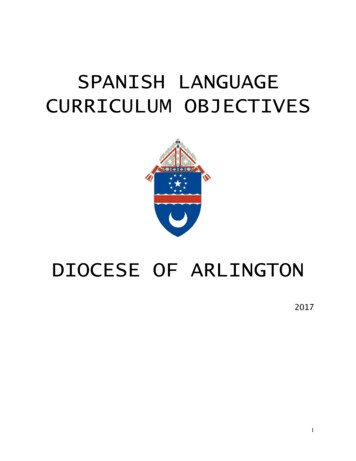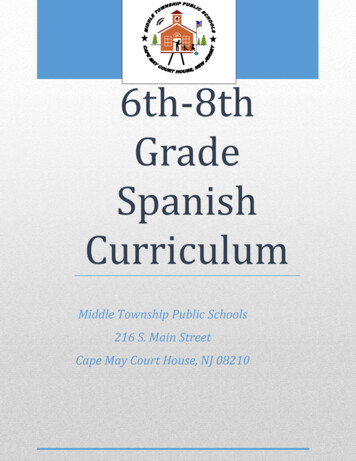
Transcription
6th-8thGradeSpanishCurriculumMiddle Township Public Schools216 S. Main StreetCape May Court House, NJ 082101 Page
Table of ContentsAcknowledgements .8Introduction.4Course Description .86th Grade Unit Plans . 5-26Pacing Guide . 6-7Unit 1 . 8-12Unit 2 .10Unit 3 . 13-22Unit 4 . 23-267th Grade Unit Plans . 1354Pacing Guide .28-29Unit 1 .13Unit 2 . 35-39Unit 3 . 40-44Unit 4 . 45-49Unit 5 . 50-548th Grade Unit Plans .18Pacing Guide .56-57Unit 1 . 58-62Unit 2 .18Unit 3 . 68-72Unit 4 . 73-77Unit 5 . 78-82Unit 6 .236th- 8th Spanish Curriculum Map . 88-892 Page
AcknowledgementsDr. David SalvoSuperintendentDr. Toni LehmanJeff OrtmanDirector of CurriculumPrincipal, Middle Township Middle SchoolCurriculum Work CommitteeSteve CollinsCurriculum Formatting and CompilationSharon RementerPamela ShuteVictoria Villano-Tirado3 Page
IntroductionThis document serves to meet all requirements of curriculum as per theMiddle Township Board of Education and the New Jersey Department ofEducation and will serve as a guide for lesson planning. Units within thecurricular framework for World Languages are designed to be taught in theorder in which they are presented. Within the units, the teachers haveflexibility of what order to present the standards.Course DescriptionNew Jersey citizens are part of a dynamic, interconnected, and technologicallydriven global society centered on the creation and communication of knowledge andideas across geographical, cultural, and linguistic borders.Individuals who effectively communicate in more than one language, with anappropriate understanding of cultural contexts, are globally literate andpossess the attributes reflected in the mission and vision for world languageseducation that follow:Mission: The study of another language and culture enables individuals,whether functioning as citizens or workers, to communicate face-to-face and byvirtual means in appropriate ways with people from diverse cultures.Vision: An education in world languages fosters a population that: Communicates in more than one language with the levels of languageproficiency that are required to function in a variety of occupations andcareers in the contemporary workplace. Exhibits attitudes, values, and skills that indicate a positive dispositionand understanding of cultural differences and that enhance crosscultural communication. Values language learning as a global literacy as well as for its long-termworth in fostering personal, work-related, and/or financial success inour increasingly interconnected world.4 Page
th6GradeSpanish5 Page
6th-8th Grade Spanish CurriculumPacing GuideUNIT TITLE1- Greetings andSmall TalkENDURING UNDERSTANDINGS 2- Describing theClassroom Students will understand how to greet someone, howto introduce themselves and ask and respond toroutine questions. They will be able to ask/answerquestions about the time and the weather and expressthe day and date.It is desired that students feel comfortable withroutine, repetitive phrases that are easily recognizedwithout significant delay or thought.It is predicted that students will confuse questions andresponses without significant repetition, time andpractice. Continued review and re-visiting of thesethemes in subsequent lessons should strengthen andimprove understanding and ability.Students will be able to recite the alphabet, spelltheir name, identify and describe classroomobjects by their size & color and begin to useother descriptive adjectives to describe peopleand things.It is desired that students begin to pronounceletters and words correctly, and comfortablyrespond to questions and commands in theclassroom without significant delay or thought.It is predicted that students will have difficultywith pronunciation and some initial grammaticallessons. Repetitive discussions, activities andsubtle corrections should assist in improvingthese .1.NH.A.17.1.NH.A.37.1.NH.A57.1.NH.B4TIMEFRAME12 class periods9 class periods6 Page
6th-8th Grade Spanish Curriculum3- DescribingPeople andThings 4- MexicanHolidays andCelebrations Students will be able to describe a person’s hairand eye color. They will be able to describethem according to physical distinctions andpersonality characteristics.It is desired that students be able to understandSpanish gender and number rules and how theyaffect the use of adjectives.It is predicted that students will have difficultywith grammatical differences between Spanishand English in areas such as adjectiveplacement and agreement.Students will understand what “Day of theDead” is, its significance and how it iscelebrated.Students will understand what “Cinco de mayo”is and how it is celebrated in Mexico and theU.S.Students will know about some typical Mexicanfoods served during these special occasions.It is predicted that students will have difficultyunderstanding and appreciating anothercountry’s culture and customs so different fromour .17.1.NH.A.37.1.NH.A57.1.NH.B410 class periods5 class periods7 Page
6th-8th Grade Spanish CurriculumContent Area:SpanishUnit Plan Title:Unit One: Greetings and Small TalkGrade(s) 6Target Proficiency LevelNoviceOverview/RationaleBeginning Spanish speakers must begin to feel comfortable expressing themselves and responding to others in everyday situations. Theyneed to know some basic vocabulary and be able to apply it in conversation. This unit will deal with some of the most common topics ofeveryday conversations: meeting others, introducing oneself, exchanging pleasantries, stating the day and date and inquiring about thetime and weather.Standard(s) (Established Goals) and Strand(s)7.1.NH.A.1 Interpretive - Recognize familiar works and phrases, understand the main idea and infer the meaning of some highly contextualized,unfamiliar spoken or written words contained in culturally authentic materials using electronic information sources related to targeted themes.7.1.NH.A.3 Interpretive – Recognize some common gestures and practices of the target culture7.1.NH.A5 Interpretive/interpersonal Demonstrate comprehension of short conversations and brief written messages on familiar topics.7.1.NH.B4 Interpersonal Ask and respond to questions, make requests and express preferences in various social situations.Technology Standard(s)8.1.P.C.1 Collaborate with peers by participating in interactive digital games or activities.8.1.8.A.4 Graph and calculate data within a spreadsheet and present a summary of results.Interdisciplinary Standard(s)NJSLSA.R2 Determine central ideas or themes of a text and analyze their development; summarize the key supporting details and ideas.NJSLSA.R4 Interpret words and phrases as they are used in a text, including determining technical, connotative and figurative meanings and analyze howspecific word choices shape meaning or tone.RST.6-8.9 Compare and contrast the information gained from experiments, simulations, video or multimedia sources with that gained from reading a text8 Page
6th-8th Grade Spanish Curriculumon the same topic.NJSLSA.W4 Produce clear and coherent writing in which the development, organization and style are appropriate to task, purpose and audience.Enduring Understandings: (What are the big ideas? What specific understandings about them are desired? What misunderstandings arepredictable?)Students will understand how to greet someone, how to introduce themselves and ask and respond to routine questions. They will be able to ask/answerquestions about the time and the weather and express the day and date.It is desired that students feel comfortable with routine, repetitive phrases that are easily recognized without significant delay or thought.It is predicted that students will confuse questions and responses without significant repetition, time and practice. Continued review and re-visiting ofthese themes in subsequent lessons should strengthen and improve understanding and ability.Essential Question(s): (What provocative questions will foster inquiry, understanding, and transfer of learning?)How do Spanish speakers make initial conversation?How do we express the time in Spanish?How do we count and use numbers in Spanish?How do we express the weather in Spanish?How do we express the day and date in Spanish?In this unit plan, the following 21st Century themes and skills are addressed:XCheck all that apply.Indicate whether these skills are E-Encouraged, T-Taught, or A-Assessed in this unit by marking E, T, A onthe line before the appropriate skill.21 s t Century Themes21 s t Century SkillsGlobal AwarenessEnvironmental LiteracyCritical Thinking & Problem SolvingECreativity and Innovation9 Page
6th-8th Grade Spanish CurriculumHealth LiteracyACollaboration, Teamwork and LeadershipCivic LiteracyTCross-Cultural and Interpersonal CommunicationFinancial, Economic, Business andEntrepreneurial LiteracyACommunication and Media FluencyAccountability, Productivity and EthicsIn this unit plan, the following Career Ready Practices are addressed:Indicate whether these skills are E-Encouraged, T-Taught, or A-Assessed in this unit by marking E, T, A on the line before the appropriate skill.CRP1. Act as a responsible and contributing citizen and employeeACRP2. Apply appropriate academic and technical skillsCRP3. Attend to personal health and financial well-beingTCRP4. Communicate clearly and effectively with reasonCRP5. Consider the environmental, social and economic impacts of decisionsECRP6. Demonstrate creativity and innovationCRP7. Employ valid and reliable research strategiesCRP8. Utilize critical thinking to make sense of problems and persevere in solving themCRP9. Model integrity, ethical leadership and effective managementCRP10. Plan education and career paths aligned to personal goalsCRP11. Use technology to enhance productivityECRP12. Work productively in teams while using cultural global competenceStudent Learning Goals/Objectives: (What key knowledge and skills will students acquire as a result of this unit? What should they eventually be able todo as a result of such knowledge and skill?)Students will know how to introduce themselves, recognize basic introductoryphrases, weather related phrases, the date and the day of the week, numbers up to30 and how to tell time.Students will be able to comprehend written and spoken dialoguerelated to meeting and greeting someone, exchanging pleasantries,the weather, inquiring about the time, day and date and parting10 P a g e
6th-8th Grade Spanish Curriculumphrases. They will be able to apply their learned knowledge byconversing in role play scenarios.Assessment Evidence:Performance Tasks:Students will demonstrate applicable knowledge through role-play scenarios andoral response exercises.Other Assessment Measures:Students will be assessed with quizzes, video questionnaires, writtenclasswork, class participation and daily translation practiceexercises.Teaching and Learning Actions: (What learning experiences and instruction will enable students to achieve the desired results?1.Instructional Strategies andActivities2.3.4.5.Video presentations :a. Standard Deviant/ “Greeting & Small Talk” & associated worksheet.b. Teacher’s Discovery videos: “Greetings” & “Calendar” w/ associated quizzes.c. Rock & Learn Video segments: Hello/numbers practice/time/days of week/months of year.d. Various You-tube videos/songs: /watch?v j91m55N7e9Ihttps://www.youtube.com/watch?v AkmBxfmlQ4whttps://www.youtube.com/watch?v XMK zZFZqqo&list PL6Hvozbgsbx7wW2JHehernnEmJklnvVlc&index 10https://www.youtube.com/watch?v 7p5zFrjxAzcPower Point presentations: Telling time.Oral/Dry Erase board response:a. What time is it?b. What is the weather today?c. How many are there?d. Daily response: What day is today? What is the date?Internet practice sites.a. “Quizlet Live” game.b. Flashcard practice (Quizlet).c. Scatter (Quizlet).d. Kahoot.Activities:a. Card game: “99”.b. Bingo: Time/weather expressions/days of week/months of year.c. Role-play scenarios: students meet, greet ask/respond to time & weather questions.11 P a g e
6th-8th Grade Spanish Curriculumd. Daily opening/closing translation activity.D- For Native Spanish speakersa. Stories from “Lecturas para Hispanohablantes ( Readings for Native Spanish speakers)b. Cultural readings/questions in SpanishResources1.2.3.4.5.Video presentations.Smart board presentations.Worksheets.Internet based flashcard/vocabulary practice sites ( Quizlet, Kahoot, Spanish-Dict, etc.).Puzzles and games.Suggested Time Frame:12 class periods of 44 minutes.D – Indicates differentiation at the Lesson Level (Identify Modifications for ELL, Gifted and Talented, Title 1, Special Education)12 P a g e
6th-8th Grade Spanish CurriculumContent Area:SpanishUnit Plan Title:Unit Two: Describing the ClassroomGrade(s) 6Target Proficiency LevelNoviceOverview/RationaleBeginning Spanish speakers must learn the alphabet, objects in the classroom and begin to learn how to describe people and things withcolors and other descriptive adjectives. This unit will also introduce some basic grammatical concepts such as masculine/feminine nounsand adjective agreement.Standard(s) (Established Goals) and Strand(s)7.1.NH.A.1 Interpretive - Recognize familiar works and phrases, understand the main idea and infer the meaning of some highly contextualized,unfamiliar spoken or written words contained in culturally authentic materials using electronic information sources related to targeted themes.7.1.NH,A.3 Interpretive – Recognize some common gestures and practices of the target culture7.1.NH.A5 Interpretive/interpersonal Demonstrate comprehension of short conversations and brief written messages on familiar topics.7.1.NH.B4 Interpersonal Ask and respond to questions, make requests and express preferences in various social situations.Technology Standard(s)8.1.P.C.1 Collaborate with peers by participating in interactive digital games or activities.8.1.8.A.4 Graph and calculate data within a spreadsheet and present a summary of results.Interdisciplinary Standard(s)NJSLSA.R2 Determine central ideas or themes of a text and analyze their development; summarize the key supporting details and ideas.NJSLSA.R4 Interpret words and phrases as they are used in a text, including determining technical, connotative and figurative meanings andanalyze how specific word choices shape meaning or tone.RST.6-8.9 Compare and contrast the information gained from experiments, simulations, video or multimedia sources with that gained from13 P a g e
6th-8th Grade Spanish Curriculumreading a text on the same topic.NJSLSA.W4 Produce clear and coherent writing in which the development, organization and style are appropriate to task, purpose and audience.Enduring Understandings: (What are the big ideas? What specific understandings about them are desired? What misunderstandingsare predictable?)Students will be able to recite the alphabet, spell their name, identify and describe classroom objects by their size & color and begin to use otherdescriptive adjectives to describe people and things.It is desired that students begin to pronounce letters and words correctly, and comfortably respond to questions and commands in the classroomwithout significant delay or thought.It is predicted that students will have difficulty with pronunciation and some initial grammatical lessons. Repetitive discussions, activities andsubtle corrections should assist in improving these areas.Essential Question(s): (What provocative questions will foster inquiry, understanding, and transfer of learning?)What are the letters of the Spanish alphabet and how are they pronounced?What are the objects in the classroom and how can we describe them?What are Spanish adjectives and how do we use them?What do we state the colors in Spanish?How do nouns reflect gender in Spanish?In this unit plan, the following 21st Century themes and skills are addressed:Check all that apply.Indicate whether these skills are E-Encouraged, T-Taught, or A-Assessed in this unit by marking E,T, A on the line before the appropriate skill.21 s t Century Themes21 s t Century Skills14 P a g e
6th-8th Grade Spanish CurriculumXGlobal AwarenessCritical Thinking & Problem SolvingEnvironmental LiteracyECreativity and InnovationHealth LiteracyACollaboration, Teamwork and LeadershipCivic LiteracyTCross-Cultural and Interpersonal CommunicationFinancial, Economic, Business andEntrepreneurial LiteracyACommunication and Media FluencyAccountability, Productivity and EthicsIn this unit plan, the following Career Ready Practices are addressed:Indicate whether these skills are E-Encouraged, T-Taught, or A-Assessed in this unit by marking E, T, A on the line before the appropriate skill.CRP1. Act as a responsible and contributing citizen and employeeACRP2. Apply appropriate academic and technical skillsCRP3. Attend to personal health and financial well-beingTCRP4. Communicate clearly and effectively with reasonCRP5. Consider the environmental, social and economic impacts of decisionsECRP6. Demonstrate creativity and innovationCRP7. Employ valid and reliable research strategiesCRP8. Utilize critical thinking to make sense of problems and persevere in solving themCRP9. Model integrity, ethical leadership and effective managementCRP10. Plan education and career paths aligned to personal goalsCRP11. Use technology to enhance productivityECRP12. Work productively in teams while using cultural global competence15 P a g e
6th-8th Grade Spanish CurriculumStudent Learning Goals/Objectives: (What key knowledge and skills will students acquire as a result of this unit? What should they eventuallybe able to do as a result of such knowledge and skill?)Students will know the Spanish alphabet, what items are in the classroom,colors and various other adjectives. They will understand the use of gender ofSpanish nouns and rules governing the use of adjectives.Students will be able to recite the Spanish alphabet and begin todevelop their pronunciation. They will be able to recognize anddescribe items in the classroom and begin to apply basic Spanishgrammar rules in describing people and things.Assessment Evidence:Performance Tasks:Students will demonstrate applicable knowledge through role-play scenariosand oral response exercises. They will demonstrate knowledge of theclassroom by properly following teacher commands. They will be able to drawand label the classroom while using descriptive adjectives.Other Assessment Measures:Students will be assessed with quizzes, video questionnaires,written classwork, class participation and daily translationpractice exercises.Teaching and Learning Actions: (What learning experiences and instruction will enable students to achieve the desired results?6.Instructional Strategies andActivitiesVideo presentations :e. Standard Deviant/ “Descriptive Adjectives” & associated worksheet.f. Rock & Learn Video segments: The Alphabetg. Various You-tube videos/songs: adjectives/classroom objects.https://www.youtube.com/watch?v QK84rTzSVKwhttps://www.youtube.com/watch?v B2Gm6MTRqTchttps://www.youtube.com/watch?v zpLQSdu4V94https://www.youtube.com/watch?v JUcu9PUh9 A7. Power Point presentations: Descriptive adjectives.8. Internet practice sites.e. “Quizlet Live” game.f. Flashcard practice (Quizlet).g. Scatter (Quizlet).h. Kahoot.9. Activities:16 P a g e
6th-8th Grade Spanish Curriculume.f.g.h.i.What’s missing? power point activityBingo: adjectives/classroom objectsDaily opening/closing translation activity.Concentration game: adjectives/classroom objectsFlyswatter gameD- For Native Spanish speakersa. Stories from “Lecturas para Hispanohablantes ( Readings for Native Spanish speakers)b. Cultural readings/questions in SpanishResources6.7.8.9.10.Video presentations.Smart board presentations.Worksheets.Internet based flashcard/vocabulary practice sites ( Quizlet, Kahoot, Spanish-Dict, etc.).Puzzles and games.Suggested Time Frame:9 class periods of 44 minutes.D – Indicates differentiation at the Lesson Level (Identify Modifications for ELL, Gifted and Talented, Title 1, Special Education)17 P a g e
6th-8th Grade Spanish CurriculumContent Area:SpanishUnit Plan Title:Unit Three: Describing People and ThingsGrade(s) 6Target Proficiency LevelNoviceOverview/RationaleBeginning Spanish speakers must be able to describe people and things. They must know the parts of the body and use descriptiveadjectives to express details, distinctions, similarities and differences.Standard(s) (Established Goals) and Strand(s)7.1.NH.A.1 Interpretive - Recognize familiar works and phrases, understand the main idea and infer the meaning of some highly contextualized,unfamiliar spoken or written words contained in culturally authentic materials using electronic information sources related to targeted themes.7.1.NH.A.3 Interpretive – Recognize some common gestures and practices of the target culture7.1.NH.A5 Interpretive/interpersonal Demonstrate comprehension of short conversations and brief written messages on familiar topics.7.1.NH.B4 Interpersonal Ask and respond to questions, make requests and express preferences in various social situations.Technology Standard(s)8.1.P.C.1 Collaborate with peers by participating in interactive digital games or activities.8.1.8.A.4 Graph and calculate data within a spreadsheet and present a summary of results.Interdisciplinary Standard(s)18 P a g e
6th-8th Grade Spanish CurriculumNJSLSA.R2 Determine central ideas or themes of a text and analyze their development; summarize the key supporting details and ideas.NJSLSA.R4 Interpret words and phrases as they are used in a text, including determining technical, connotative and figurative meanings andanalyze how specific word choices shape meaning or tone.RST.6-8.9 Compare and contrast the information gained from experiments, simulations, video or multimedia sources with that gained fromreading a text on the same topic.NJSLSA.W4 Produce clear and coherent writing in which the development, organization and style are appropriate to task, purpose and audience.Enduring Understandings: (What are the big ideas? What specific understandings about them are desired? What misunderstandingsare predictable?)Students will be able to describe a person’s hair and eye color. They will be able to describe them according to physical distinctions andpersonality characteristics.It is desired that students be able to understand Spanish gender and number rules and how they affect the use of adjectives.It is predicted that students will have difficulty with grammatical differences between Spanish and English in areas such as adjective placementand agreement.Essential Question(s): (What provocative questions will foster inquiry, understanding, and transfer of learning?)What are the parts of the body and how do we describe them with colors and other adjectives?What is “adjective agreement” and what are its implications and applications in Spanish grammatical structures.How do we use the verb “tener” to express what someone “has”?How do we use the verb “ser” to describe people and things?19 P a g e
6th-8th Grade Spanish CurriculumIn this unit plan, the following 21st Century themes and skills are addressed:XCheck all that apply.Indicate whether these skills are E-Encouraged, T-Taught, or A-Assessed in this unit by marking E,T, A on the line before the appropriate skill.21 s t Century Themes21 s t Century SkillsGlobal AwarenessCritical Thinking & Problem SolvingEnvironmental LiteracyECreativity and InnovationHealth LiteracyACollaboration, Teamwork and LeadershipCivic LiteracyTCross-Cultural and Interpersonal CommunicationFinancial, Economic, Business andEntrepreneurial LiteracyACommunication and Media FluencyAccountability, Productivity and EthicsIn this unit plan, the following Career Ready Practices are addressed:Indicate whether these skills are E-Encouraged, T-Taught, or A-Assessed in this unit by marking E, T, A on the line before the appropriate skill.CRP1. Act as a responsible and contributing citizen and employeeACRP2. Apply appropriate academic and technical skillsCRP3. Attend to personal health and financial well-beingTCRP4. Communicate clearly and effectively with reasonCRP5. Consider the environmental, social and economic impacts of decisionsECRP6. Demonstrate creativity and innovationCRP7. Employ valid and reliable research strategiesCRP8. Utilize critical thinking to make sense of problems and persevere in solving themCRP9. Model integrity, ethical leadership and effective management20 P a g e
6th-8th Grade Spanish CurriculumCRP10. Plan education and career paths aligned to personal goalsCRP11. Use technology to enhance productivityECRP12. Work productively in teams while using cultural global competenceStudent Learning Goals/Objectives: (What key knowledge and skills will students acquire as a result of this unit? What should they eventuallybe able to do as a result of such knowledge and skill?)Students will know how to describe people and things. They will know how todescribe people physically and by their personality and characteristics. Theywill understand how to use adjectives grammatically.Students will be able to describe people according to theirhair/eye color and other physical characteristics. They will beable to describe their personal characteristics using adjectives.Assessment Evidence:Performance Tasks:Students will demonstrate knowledge through TPR response and oral Q & A.They will draw characters according to given physical characteristics. They willcomplete and review worksheets that will demonstrate their understanding.They will participate in computer activities, both individually and in teams thatwill reinforce and clarify vocabulary and grammatical concepts.Other Assessment Measures:Students will be assessed with quizzes, video questionnaires,written classwork, class participation and daily translationpractice exercises.21 P a g e
6th-8th Grade Spanish CurriculumTeaching and Learning Actions: (What learning experiences and instruction will enable students to achieve the desired results?Instructional Strategies andActivities10. Video presentations :h. Teacher Discovery video: “Body Parts”i. Rock & Learn Video segments: “Who Am I?” & “The Body”11. Total Physical Response/Simon says, “ Touch your (body part)”12. Internet practice sites.i. “Quizlet Live” game.j. Flashcard practice (Quizlet).k. Scatter (Quizlet).l. Kahoot.13. Activities:j. Draw “Monsters” according to given number of body parts. Present to class.k. Bingo: Descriptive adjectives/body partsl. Daily opening/closing translation activity.m. Concentration game: parts of the body/descriptive adjectivesn. Worksheet activities: Compare the animals/describe the basketball players by physicalcharacteristicso. Flyswatter gameD- For Native Spanish speakersa. Stories from “Lecturas para Hispanohablantes ( Readings for Native Spanish speakers)b. Cultural readings/questions in SpanishResources11.12.13.14.15.16.Video presentations.Smart board presentations.Worksheets.Internet based flashcard/vocabulary practice sites ( Quizlet, Kahoot, Spanish-Dict, etc.).Puzzles and games.Drawing/labeling activitySuggested Time Frame:10 class periods of 44 minutes.D – Indicates differentiation at the Lesson Level (Identify Modifications for ELL, Gifted and Talented, Title 1, Special Education)22 P a g e
6th-8th Grade Spanish CurriculumContent Area:SpanishUnit Plan Title:Unit Four: Mexican Holidays and CelebrationsGrade(s) 6Target Proficiency LevelNoviceOverview/RationaleBeginning Spanish spea
Beginning Spanish speakers must begin to feel comfortable expressing themselves and responding to others in everyday situations. They need to know some basic vocabulary and be able to apply it in conversation. T
